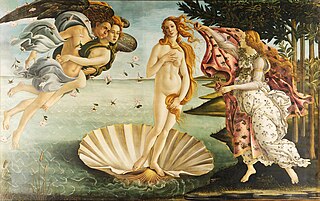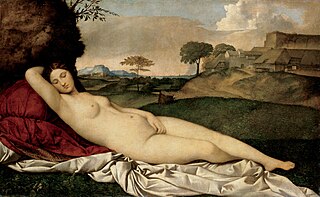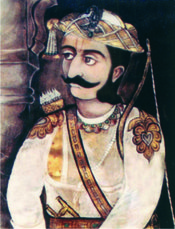
The Birth of Venus is a painting by the Italian artist Sandro Botticelli, probably executed in the mid 1480s. It depicts the goddess Venus arriving at the shore after her birth, when she had emerged from the sea fully-grown. The painting is in the Uffizi Gallery in Florence, Italy.

Sambar is a lentil-based vegetable stew, cooked with pigeon pea and tamarind broth. It is popular in South Indian, Sri Lankan and Maldivian cuisines. The stew has been adapted into Burmese cuisine as a popular accompaniment to Burmese curries.

The Sleeping Venus, also known as the Dresden Venus, is a painting traditionally attributed to the Italian Renaissance painter Giorgione, although it has long been usually thought that Titian completed it after Giorgione's death in 1510. The landscape and sky are generally accepted to be mainly by Titian. In the 21st century, much scholarly opinion has shifted further, to see the nude figure of Venus as also painted by Titian, leaving Giorgione's contribution uncertain. It is in the Gemäldegalerie, Dresden. After World War II, the painting was briefly in possession of the Soviet Union.

Raghoji I or Raghuji the Great of the Bhonsale dynasty, was a Maratha general who took control of the Nagpur Kingdom in east-central India during the reign of Shahu I. His successors ruled the kingdom until 1853.
Ram Gopal Vijayvargiya (1905–2003) was an Indian painter. He was also a poet and a writer.
Govind Ballal Kher, historically known as Govind Pant Bundela, was a Military General of Peshwas in Northern India during 1733 to 1760. Peshwa Bajirao appointed him his trustee for the 1/3 kingdom rewarded to him by Maharaja Chhatrasal in Bundelkhand. He ruled the city of Kalpi and later it was given as jagir to his descendant Nana Govinda Rao. After this Govind Rao ruled the Jalaun State.
Jam Feruzuddin Al-Maroof Jam Unar bin Babinah was the first ruler of the Samma dynasty, which ruled Sindh and parts of Punjab from 1335–1520 C.E.

The history of Nagpur, in central India, spans over 5,000 years, including the Kingdom of Nagpur in the 18th and 19th century. Human existence around present-day Nagpur city can be traced back 3,000 years to the 8th century BC. Menhir burial sites at Drugdhamna indicate megalithic culture existed around Nagpur and is still followed in present times.

Barak Bakhar is an Israeli association football manager and former footballer. He is the head coach of Red Star Belgrade.

Belawadi Mallamma was a queen of Belawadi kingdom (samshtana). She is credited with being the first queen in history who built and trained a women's army.
Shivaji was the founder of the Maratha Empire in the Indian subcontinent. The early life of Chhatrapati Shivaji Maharaj is a topic of great interest in the popular culture of India, especially in the Maharashtra state, where he spent most of his life. This article describes Shivaji's life from his birth until the age of 19 years (1630–1649).
Bakhar is a form of historical narrative written in Marathi prose. Bakhars are one of the earliest genres of medieval Marathi literature. More than 200 bakhars were written in the seventeenth to nineteenth centuries, the most important of them chronicling the deeds of the Maratha ruler Shivaji. Bakhars are considered valuable resources depicting the Maratha view of history, but also criticized for falsification, embellishment and magnification of facts.
Janki Bhosale was Empress consort of the Maratha Empire as the first wife of Rajaram I.

The Last Harvest: Paintings of Rabindranath Tagore is a book on Rabindranath Tagore (1861–1941) and his paintings edited by R. Siva Kumar. In 2011 it was produced in conjunction with the traveling exhibition The Last Harvest: Paintings of Rabindranath Tagore.

Pratap Singh Bhonsale was the eighth and last Chhatrapati of the Maratha Empire from 1808 to 1819. He was also the Raja of Satara until 1839, when he was replaced with Shahaji of Satara by the British.
The Battle of Salher was a battle fought between the Marathas and the Mughal Empire in February 1672 CE. The battle was fought near the fort of Salher in the Nashik district. The result was a decisive victory for the Marathas. This battle is considered particularly significant as it is the first pitched battle in which the Mughal Empire lost to the Marathas.
Events in the year 1867 in India.

Shriniwasrao Parshuram, popularly known as Shripatrao Pratinidhi or Shripatrao Pant Pratinidhi, was a General of the Maratha Empire. He served as Pratinidhi during Shahu I's reign. After the death of his father Parshuram Pant Pratinidhi in 1718, Shripat Rao won the favour of Shahu by his brilliant efforts as a soldier fighting many battles in the defence of the Maratha Empire. In 1718, he was appointed as the Pant Pratinidhi of Maratha Empire.
Shakakarte Chhatrapati Shri Shivaji Maharaj yanche Saptaprakaranatmak Charitra, better known as Chitnis Bakhar, is a Marathi language biography of Shivaji, the founder of the Maratha Empire. It was written by Malhar Ramaaao Chitnis, a biographer and historian. His great-grandfather was the "celebrated" chitnis under Shivaji. The biography had been ordered to be written by king Shahu II of Satara, but the work was completed after his death in 1808, during 1810–1811. The author wrote seven bakhars (chronicles) in total, including six biographies of the Maratha kings (chhatrapatis), and a treatise on political diplomacy('Rajniti') which he based on Sanskrit Nitishastras and other old Sanskrit literature.

Shri Shiva Chhatrapatichi 91 Kalmi Bakhar, better known as 91-Kalami Bakhar, is a Marathi language biography of Shivaji, the founder of the Maratha Empire. Its name is also transliterated as 91 Kalmi Bakhar, 91 Qalmi Bakhar, 91 Qalami Bakhar, and Ekkyannav Kalmi Bakhar. Organized into 91 sections, it is an important source of information about Shivaji's life for modern historians. The original text was composed by Shivaji's courtier Dattaji Trimal, but is now lost: its extracts survive in later recensions. Although the original text was the earliest bakhar about Shivaji's life, the interpolations in these recensions have rendered the surviving text unreliable.










